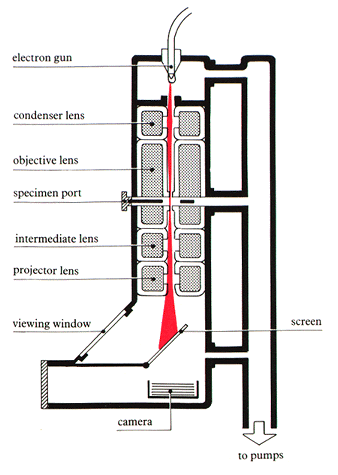
Electron Microscopy
excerpt from Microcosmos by Jeremy Burgess, Michael Marten and Rosemary Taylor
� Copyright 1987, Cambridge University Press, reproduced by permission.
- General Design
- Image Formation in the TEM
- Image Formation in the SEM
- Biological Specimens
- Materials and Inorganic Specimens
Image Formation in the TEM
The illumination system of the TEM consists of the electron gun and one or, more usually, two condenser lenses. Electrons leaving the heated tungsten filament that forms the electron gun are accelerated towards an anode plate. They pass a biased grid (the Wehnelt cylinder) and travel through a hole in the anode plate before beginning their journey down the microscope column. First they encounter the condenser lenses, which concentrate the electron beam and bring it to a point of focus some way above the specimen plane. The condenser system contains a small physical aperture in the form of a disc of metal such as platinum or molybdenum with a precisely circular hole at its center. This aperture controls both the intensity and the angle of convergence of the electron beam. The operator usually has a choice of three aperture sizes, from a hole 25 micrometers in diameter up to 100 micrometers. Aperture size, together with the precise level of focus of the condenser lenses, form the operator's control of 'brightness' in the final image.
